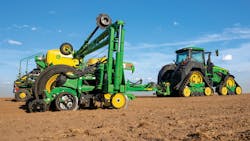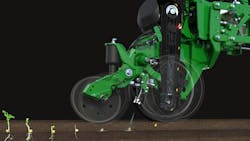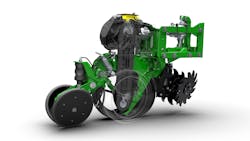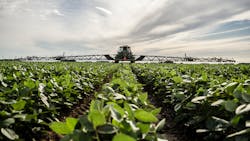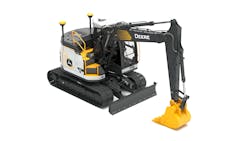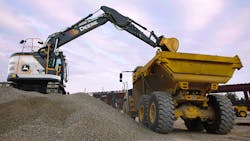Technology is Key to the Future of Farming
John Deere once again highlighted the technology advancements taking place in the agricultural industry at CES 2023. As John May, Chairman and CEO of Deere & Co., emphasized during the company’s keynote speech at the event, farmers are being tasked with doing more but with fewer resources.
READ MORE technology news from CES 2023.
Over the next 25 years the global population is expected to reach close to 10 billion he said, requiring 50% more food to be grown as the population increases and diets change around the world. However, changing weather patterns, a lack of skilled labor and declining availability of farmland is presenting challenges.
But with technology such as automation and precision guidance, John Deere is aiming to help farmers do more with less. In addition, use of more technology will help to reduce input costs and impacts on the environment.
“In the past, farmers would grow more by using more – bigger machines, more horsepower, more seeds and more nutrients,” said May. “This approach alone doesn't work today. There's less arable land, less rural labor, less time to do [farm work] due to weather volatility and rising input costs. Technology is the solution to these challenges.
“Technology allows farmers to create more with fewer resources, doing more with less. That is the path forward to providing for all of us, in feeding our growing world. And that's why at John Deere we're focused on [technology]…empowering our customers to have an economically and environmentally sustainable business that provides for themselves and their families while ensuring food security for the world.”
To help customers be more productive and sustainable, John Deere unveiled two new technologies at CES 2023 – ExactShot for fertilizer application and its first fully-electric excavator.
Vision will Continue Transforming Agriculture
At the 2022 edition of the Consumer Electronics Show (CES), John Deere unveiled its fully autonomous 8R Tractor which makes use of artificial intelligence and computer vision technology to enable safe operation without a person in the tractor cab.
WATCH MORE: John Deere Autonomous Tractor Benefits from Deep Learning and Computer Vision
Vision technology like this will be vital to the future of the agricultural industry said Julian Sanchez, Director of Emerging Technology at John Deere, during the company’s CES keynote. Farmers have always relied on vision to monitor their crops and advancements in technology are enabling improvements beyond what the human eye is capable of – despite how advanced human vision already is.
Machine and computer vision through the use of advanced cameras, sensors and software are enabling greater visibility and automation of processes. As such, the company makes use of these capabilities for its new ExactShot system which helps farmers improve fertilization of crops by applying it only where necessary.
ExactShot combines sensors and robotics to place starter fertilizer—necessary for the health of the crops—precisely on seeds as they are planted in the soil. Typically, a continuous flow of fertilizer is applied to an entire row of seeds. However, by placing it only on the seeds the amount of fertilizer needed is minimized, reducing costs and environmental impacts. John Deere states ExactShot can reduce the amount of fertilizer needed during planting by more than 60%.
As John Deere explained, the system uses a sensor to register when each seed is being placed into the soil. At this moment, the robotic portion of the system sprays only the amount of fertilizer needed, about 0.2 ML, on the seed as it goes into the ground. This can be accomplished at speeds up to 10 mph, ensuring farmers maintain productivity.
This precision is possible because of the advancements possible in vision and associated technologies over the years. Cameras and sensors have become better able to detect objects and provide visibility of the environment while John Deere has worked to appropriately train datasets for agricultural applications. Objects in the middle of a field are not as common as on a roadway, but it is necessary to see and understand aspects which are always present such as the soil, tree lines and sky noted Sanchez.
One of the most exciting aspects of vision technology is the ability to augment human vision he said. “Human vision is really sophisticated…[it] may be one of the most sophisticated systems in the universe. We’re now at the point though where we can add superhuman capabilities with machine vision to help farmers perform tasks with precision.
“As we move into the future, vision will continue to be a critical technology,” he added. “We’re just scratching the surface” with the capabilities possible and how vision technologies can transform the agricultural industry.
READ MORE: Danfoss Looks to Overcome Labor Challenges with Autonomous Solutions
Sustainability to Take Various Forms
Besides the productivity benefits technology can provide farmers, Jahmy Hindman, Chief Technology Officer at John Deere, said during the keynote that technology can offer environmental benefits as well such as through the reduced use of fertilizer with ExactShot.
Creation of autonomous vehicles like the 8R Tractor can also benefit the environment. By removing humans from the operation cab, there is less chance of rework as the tractor knows the exact paths and tasks it needs to follow and is able to do so precisely. This helps to reduce fuel use and emissions.
While electrification is growing in many sectors, Hindman said electrification of high-horsepower equipment running on farms faces deep technical challenges which make an electric-only future unlikely in the near term.
“A typical day's work for the 8R Tractor includes operating continuously for 14 hours at 75% of its peak power, about 230 kilowatts. That's the energy equivalent of 38 Tesla Model 3 long-range batteries,” he explained. This would double the weight and size of the tractor while increasing operational costs as well to produce the amount of energy required.
Like many companies, John Deere sees a mixed approach to achieving emissions reduction goals. Use of biofuels and renewable diesel – which can be created using crops and byproducts already on a farm – will be more feasible options for heavier duty equipment applications. “Biofuels produced from corn, or soybean feedstocks, such as ethanol and renewable diesel, produce about 50% less greenhouse gas emissions compared to their petroleum-based counterparts,” said Hindman.
“Using today's precision farming practices, and the current U.S. grid power generation, bio carbon intensity rivals that of electrification. Additionally, future advancements in precision agriculture technology and sustainable agricultural practices will create significant opportunity to further reduce the carbon intensity of biofuels,” he said.
Electrification has its Place
Hindman said John Deere’s excitement for the future of biofuels shouldn’t take anything away from electrification as the world will best benefit from a range of solutions, not just one. It will be about finding the right solution for the vehicle and application at hand.
“In the construction industry in particular, electrification is going to have an enormous impact on both workers and communities around the world,” he said. Because of this, at CES 2023 John Deere unveiled its first fully electric excavator.
The 145 X-Tier is a compact machine powered by batteries from Kreisel Electric, a developer of cooled battery technology, which John Deere acquired a majority stake in last year. It includes many of the advanced technologies and design features of other John Deere machines while providing reduced emissions and noise.
“The lower noise of electrified construction equipment in urban areas allows the work to begin earlier and to end later,” said Hindman. “This causes less societal disruption, and it creates a safer worksite through an improved ability for the workers to communicate on the job. This will result in projects getting completed faster, all while eliminating combustion emissions.”
John Deere worked together with Kreisel to invest in the development of batteries which can provide the high performance and longer battery life necessary in industrial applications like construction and agriculture. Kreisel also offers charging technology that can speed up battery charging while reducing costs of doing so. Automotive-style charging connections will be utilized on the 145 X-Tier and future electric machines to enable use of conventional charging stations when possible.
Since 2013, John Deere has been developing hybrid-electric wheel loaders which has provided experience it can bring to development of future full-electric machines. The company has set a target of delivering over 20 electric and hybrid-electric models by 2026.
Multiple Market Applications
During the CES keynote, Hindman emphasized the applicability of John Deere’s solutions across industries. “Our technology isn't only being used in agriculture. It's also critical in construction and in road building,” he said.
This goes for the precision and automation technologies as well as the alternatively fueled and powered machines under development.
For instance, the 145 X-Tier electric excavator may initially be seen as a machine for construction applications but compact equipment like this can also be used for various tasks on farms. The lower noise and emissions the electric machine offers can greatly benefit the health and safety of both farmers as well as their livestock and crops.
And in construction, automation and precision technologies are helping to ensure work is completed in a safe and efficient manner. Systems like grade control allow a machine to dig exactly the amount of dirt necessary in a defined space, eliminating rework and easing the task for operators which is becoming increasingly important in both construction and agriculture due to the lack of skilled labor entering these markets.
“Deere technologies like ExactShot, electrification and autonomy are ready for large scale use to improve outcomes for customers to create the food, fuel and infrastructure we all need and to improve our planet for future generations,” said Hindman.
May concluded the keynote by saying John Deere is “not in the business of creating technology just because it’s cool. We create technology to address specific challenges, problems or needs.
“Technology is the key to driving sustainability on the farm and construction sites and empowering our customers to be more efficient and profitable in the face of significant challenges.”
John Deere Wins Two CES Innovation Awards
For the fourth consecutive year, John Deere has received Innovation Awards from the Consumer Technology Association (CTA), organizers of CES.
John Deere was named a CES 2023 Innovation Awards Best of Innovation honoree in the Robotics category and an honoree in the Vehicle Tech & Advanced Mobility category for its 8R fully autonomous tractor.
The awards program is designed to honor outstanding design and engineering in 28 categories. The Robotics category highlights those innovations related to programmable or otherwise intelligent machines capable of performing specific tasks or replicating human movement or interactions while the Vehicle Intelligence & Advanced Mobility category highlights automotive and other transportation products and services that integrate technology into the driving or riding experience.
About the Author
Sara Jensen
Executive Editor, Power & Motion
Sara Jensen is executive editor of Power & Motion, directing expanded coverage into the modern fluid power space, as well as mechatronic and smart technologies. She has over 15 years of publishing experience. Prior to Power & Motion she spent 11 years with a trade publication for engineers of heavy-duty equipment, the last 3 of which were as the editor and brand lead. Over the course of her time in the B2B industry, Sara has gained an extensive knowledge of various heavy-duty equipment industries — including construction, agriculture, mining and on-road trucks —along with the systems and market trends which impact them such as fluid power and electronic motion control technologies.
You can follow Sara and Power & Motion via the following social media handles:
X (formerly Twitter): @TechnlgyEditor and @PowerMotionTech
LinkedIn: @SaraJensen and @Power&Motion
Facebook: @PowerMotionTech

Leaders relevant to this article:
